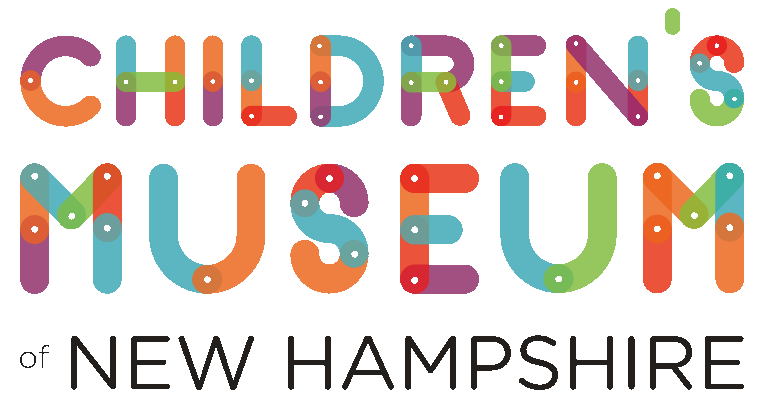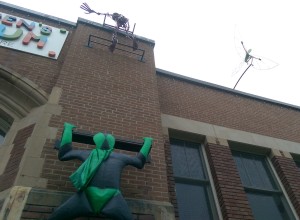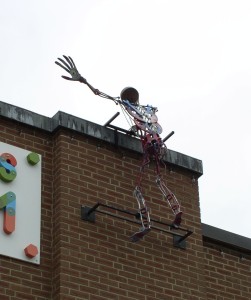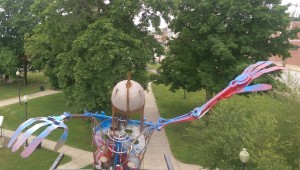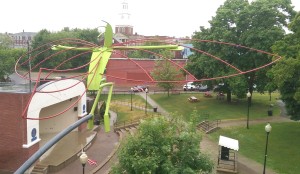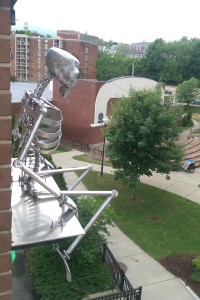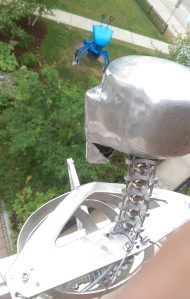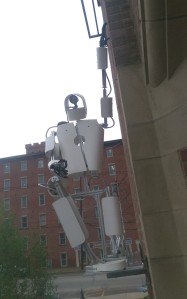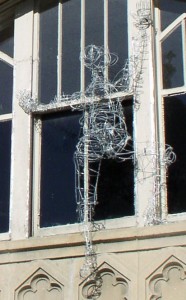Meet the CMNH Staff: Taylore
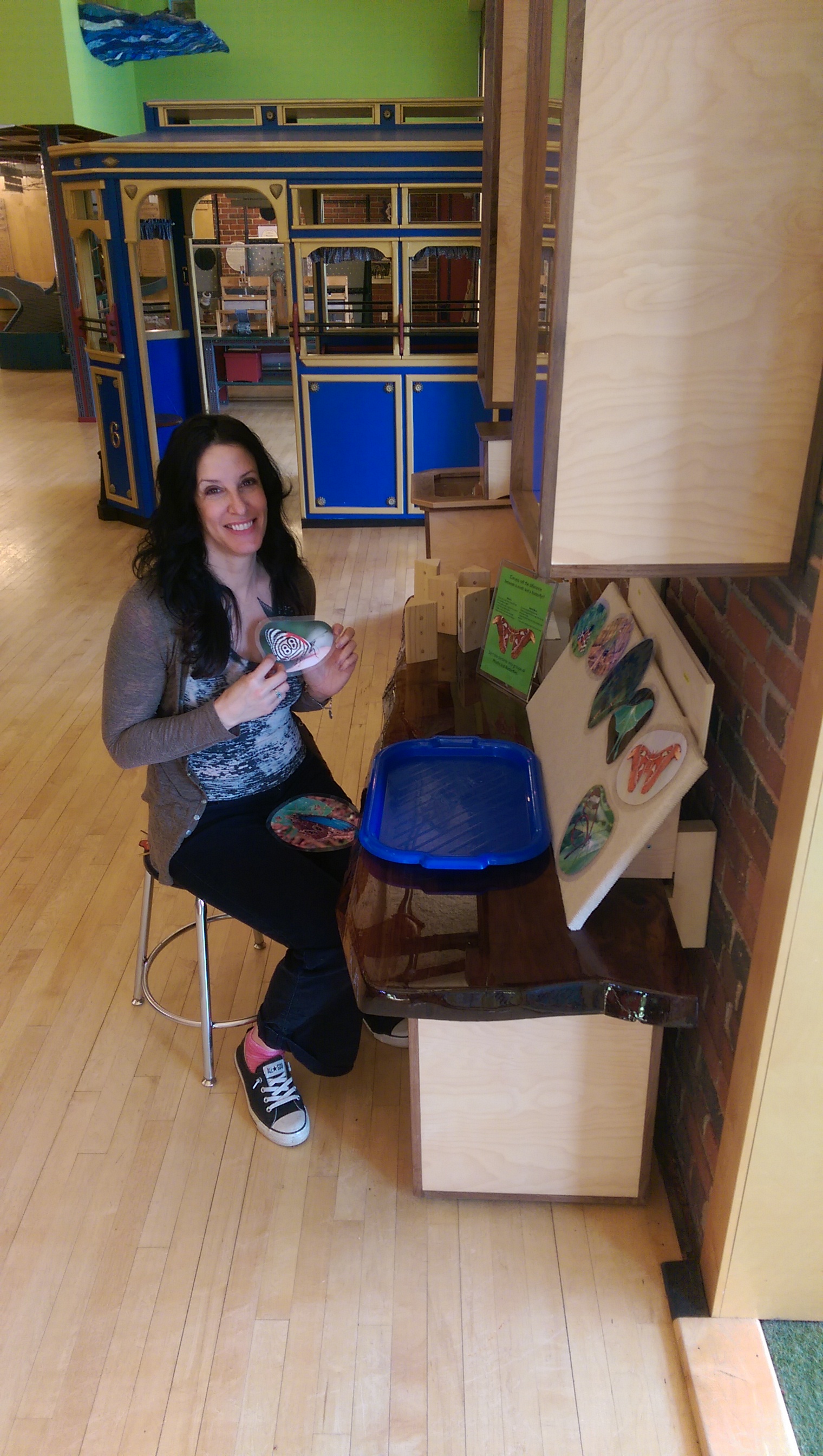
Name: Taylore Kelly
Title: Marketing and Developing Assistant
How Long She Has Been at CMNH: 10 months (October 2014)
What is the most fun part of your job?
The lightness of everything, since it’s a Children’s Museum. The people I work with too. I like that there’s a very childlike atmosphere, even though we are all professionals. I mean, what kind of job can you go to when you can say, "I have a leopard shark!"? (Taylore immediately picks up a leopard shark puppet from elsewhere in the office and poses with it!)
What is something that people may not know about you?
I play chess. I have since I was five! My dad taught me because my mother wouldn’t play with him and he needed someone to beat.
What is your favorite exhibit at CMNH and why?
Part of the section of the CochecoSystem exhibit known as the Naturalist Study. I love animals and nature so this exhibit really speaks to me!
Ascent or Descent
A Public Art Collaboration
Have you been by the Children’s Museum of New Hampshire recently? There seems to be a group of characters climbing . . . sitting . . . jumping . . . flying? Are they climbing up . . . sideways . . . down? Are they friendly or not so nice? Where did they come from and what are they doing on the front of CMNH?
Ascent or Descent is a collaborative public art project designed by the Children’s Museum of New Hampshire with six Seacoast area artists and craftspeople. This project is designed to make you curious and wonder what it is, exactly, that's happening with these figures upon our facade and what the different stories may be behind each one. We purposefully kept our description of a 'humanoid sculpture' request very broad when potential contributors were contacted. We wanted to show a diverse group of 'people' created in a variety of styles using a multitude of materials.
David Masse is a local blacksmith living on the southeastern coast of Maine who used this opportunity to design and construct something different than he would typically.
Masse decided to create a superhero and shaped it by using forged steel. He then added a fabric cape that blows in the wind. What do you think this superhero's codename is? What are his powers and how did he get them? What if he (or she!) isn't a hero . . . but a villain?!
You can check out more of David Masse's work on his website.
Rick Burns, a sculptor working based in Berwick, ME, describes his work as "creating Industrial Symbolic Abstractions using metal, wood, clay and mixed media".
If you look closely at his sculpture, you can discover some hidden objects! Do you see the wrenches that make up the arms between the elbow and the wrist?
What about the gears inside the chest? Do the gears help this character move? Does he have to be wound up like a toy? And, of course, you can't possibly miss the incredibly cool medieval helmet with pieces of chain mail. This "humanoid sculpture" is ready for anything!
You can find more creative works of art from Rick Burns at his website.
Adam Pearson is a New Hampshire based sculptor and craftsman. His child-sized figure is jumping . . . or is he flying . . . off the roof of the Children's Museum! Is this the first time he's opened up his wings and flown? Is he looking for food . . . or is he playing a game? Is he headed towards the park . . . or higher into the trees?
This sculpture, the highest piece in the installation, was created by Pearson cutting, bending and welding the metal and steel of the green body and the large red tail and swooping wingspan.
More of Adam Pearson's work can be found on his website.
Chris Wright is a local artist and Director at the Port City Makerspace. For Ascent or Descent, Wright designed and created a piece that is fashioned almost entirely from aluminum. This includes the frame, bones, ribs, head, and extremities!
Wright fabricated every piece of the sculpture, including all the individual vertebrae in the articulated spine.
There was a time not too long ago that Nate Walker's Giant Blue Crab sculpture was one of the only pieces of public art in the city of Dover. Now, Wright's piece joins five other pieces of public art looking down at art in several places in Henry Law Park!
Like Chris Wright, Jeff Gunn is also a Director at the Port City Makerspace and a local craftsman. Gunn began with aluminum to create the general form of the body for this robot . . . or is it astronaut . . . or is it robot astronaut?
He then heated and bent PVC boards to create the white outer shell around the aluminum. To design and produce the hands and other smaller parts for this piece, Gunn used some newer technology: a 3D printer!
One of the coolest features of this piece is one that can't be seen from the ground - but its effect can! On the top of right shoulder, Gunn installed a solar panel. The panel is connected to the "eye" bulb of the robot figure. So after a long day of bright sunshine, a cyclopean beam of light emerges as dusk falls. Is he guarding the museum . . . or is he guarding the park? Is he taking a picture with his eye . . . or shooting lasers?
Kali Ann Rocheleau is an artist who enjoys exploring many different mediums, including charcoal, watercolor, sculpture, and cartooning. She lives in Portsmouth with her fiancée and loves to create art whenever she can.
Rocheleau chose to make sculpture with a more whimsical, pencil-sketch like quality. She created this sculpture using bent and twisted pieces wire. One of the coolest part's of this central piece of the installation is that depending on where you're viewing it from, it seems to change shape. From one angle it appears to be a woman, but from another - a man. From the outside you can see its hands and fingers in great detail, while the feet and toes are better viewed from inside. This piece also blends in with the building almost perfectly. Is it because the figure has the ability to turn invisible? Is she made up of water . . . or is it air?
More of Kali Ann Rocheleau's art can be found on her Facebook page.
The amazing . . . or is it magical . . . or is it scientific . . . or is it fantastical figures that make up Ascent or Descent will be visiting the museum and Henry Law Park from June to the end of October 2015. For those interested in previous public art projects by the Children's Museum of New Hampshire, check out our look at Bryan Rutland's abstract art piece that adorned our building through this last winter and spring or at the journey of how artist Nate Walker and the Dover Middle School Art Club designed, created and installed the Octopus Bike Rack in front of CMNH.
- - - Begin Transmission - - -
A Strange Communication Arrived This Morning . . .
When CMNH Staff arrived to work this morning things were definitely . . . different. The exterior facade of our building and our roof had received . . . visitors . . . in the night.
Who are they? Where do they come from? What do they want?
All that was left for us was this video . . .
CMNH Top 10: Orientation Quotes
Look no further for advice on perfume use, hair care and dental hygiene
Any workplace is going to generate some humorous quotes now and again, but when your workplace is a Children's Museum, your hilarious quote percentage increases exponentially. The most humorous exchanges tend to happen during our Group Visit orientations when we chat with the children and create an open question and answer dialogue that's intended to refresh chaperones and students on museum rules and fill them in on the activities and programs happening that day.
In honor of legendary late night television host David Letterman signing off for the final time this week, I present to you:
The Top Ten Kids' Quotes from this Week
(Yes - just this week.)
#10. "Why do you have a beard?"
This was in response to me asking, "Does anyone have any questions before we start exploring the museum?" To be fair, this kindergartener had a question and he certainly asked it.
"Just because," I answered, quickly seeing in his face what a disappointing answer this was for him.
"But . . . WHY?!" he protested.
I thought for a quick second. (A quick second is about all you can afford yourself when dealing with 40+ 5-year-olds eager to start identifying dinosaur bones.)
"Well, my wife would tell you it's because I'm lazy," I began, getting a laugh from the chaperones, "But I like it because I think it's super cool and it keeps my face warm when it's cold and windy outside."
He nodded his head in approval.
#9. "Can I call you Tall Boy?"
Holding the door open for a school group that just tumbled off the bus Wednesday morning, one of the children - who was between 4 and 5 years old - looked up at me in awe and asked the aformentioned question. To be fair, I'm quite tall at 6'5" and get remarks from full grown adults so I certainly expect it from children who are usually hovering between 3 and 4 feet tall. That said, "Tall Boy" certainly beats, "He must be the Castle Ogre", which a father told his daughter one day years ago when I was cleaning up the Pattern Palace exhibit.
Full disclosure: I told the young man that he could absolutely call me, "Tall Boy". He never did after that, but I think he was happy knowing that he had permission if the need arose.
#8. "Why are you wearing so much perfume?"
A first grader visiting from out of state asked me this question earlier this week. It's a good question. It's a really good question. I appreciate that she wouldn't be bothered with the thought of me - a very (as we've covered) tall, bearded man - wearing perfume, but the sheer overuse of the flowery scent is what clearly upset her. It should be stated that she asked these words with a very visibly scrunched up face that implied olfactory offense. She was also approximately 30-40 feet away from me. This was some strong perfume. I explained to her that I wasn't wearing any perfume.
"I know. But why so much of it?" she pressed.
This, my friends, is what we call an unwinnable war. I knew conceding defeat was my only viable option.
"I don't know why I used so much of it. I'll be more careful in the future," I solemnly swore to her.
She nodded her head in approval.
#7. "I've got it! You're brother and sister!"
Meghan, an Experience Guide - Educator here at CMNH, and I were jointly leading a large orientation earlier this week in Henry Law Park. Taking advantage of the nice weather, we had the students and teachers file in to the bleachers in front of the Rotary Amphitheater so we could go over the shape of the day with them. Once we introduced ourselves and found out who in the group were returning visitors and who were here for the first time, we opened the floor up for suggestions of potential rules of the museum. Even if a child supplies us with a rule that isn't necessarily "correct", we always know to redirect and focus on the positive parts of what they said thank them for their contribution.
Thus, "Don't poke any of the animals or climb their cages", will get some sort of, "Oh, I WISH we had live animals! But if we did, you are absolutely correct that we couldn't climb their cages. Speaking of animals, who know's what an osprey is? Because we have an osprey nest that . . ." and so forth.
It's hard to catch us off guard. There isn't much we haven't heard. Until this week.
"Who knows a good rule to remember at the museum?" Meghan asked. She called on a Kindergartner in the front row who had his hand raised as high as he could hold it.
"I've got it," he yelled triumphantly. "You're brother and sister!"
Meghan and I tried our best not to laugh. Meghan, understandably shorter than me - with brown hair that's cut long in two sections with blue streaks at the end - has no glasses (as I do) and looks absolutely nothing like me. But this boy was utterly convinced that he had finally solved a mystery that didn't exist.
"Awww, that would be cool if we were," Meghan told the boy. "But we're not sister and brother, I'm afraid. Does anyone else have an idea about a good museum rule?"
A hand, belonging to a boy with very large, curly hair, shot up immediately from the second row. Meghan called on him.
"You must be a Mommy and Daddy together!" he yelled out.
Several other children in the class started nodding their heads satisfactorily, happy to know that even after a false start, it was good to know that Meghan and I were married and, clearly, also had children.
Meghan and I explained quickly that we were in no way related outside the museum and moved forward with a list of museum rules.
#6. "MEL GIBSON!"
When a group of second graders were asked if they had any questions this week, a dark-haired girl in a rainbow sweatshirt raised her hand tentatively. We called on her and she quietly said, "Do . . . do you want to know my name?" Instantly charmed (as we often are), we responded enthusiastically that we, "absolutely wanted to know her name".
"Madison," she responded quietly but confidently and with a smile.
"It's nice to meet you, Madison!" we told her.
Another hand shot up from right behind Madison. A boy, with a grin equal parts teeth and former teeth, seemed to be vibrating with energy.
"Yes, you. In the back," I called.
"Do you want to know my name?" he asked, with none of the shy hesitation that Madison had exhibited.
The whole class seemed as if it was frozen in anticipation waiting for my answer, all their tiny lungs holding their breath at the same time. I sensed something was off but pushed forward nevertheless.
"I sure do," I answered with a large grin.
"MEL GIBSON!" he shouted back.
Now, dear reader, I want you to do me a favor. I want you to think about a time that you laughed so hard that your cried. You cried, your sides hurt and you ran out of breath. You needed to hold on to a fixed object just to steady yourself and regain your composure. Can you envision it?
Now multiply that by 7,000.
The children just absolutely fell out.
They. fell. out.
An absolute cacophony of laughs. Hyenas temporarily replaced these children for the duration of the ol' "Mel Gibson" punchline. I do not presume to understand the "Mel Gibson" joke. Like many early Elementary jokes, I'm quite sure the element of surprise is far more important than the element of logic. All I know is that there's a class of second graders in the state of New Hampshire that are quite confident that they pulled a classic "Mel Gibson" on me. What that means, I have no idea. I'm not sure they do either. But, boy, did they love it.
#5. "Are you really human?"
"Yes, I am," I told the boy, somewhat startled.
"Oh. Good. I told them you were."
I received no explanation who "them" was nor why this hypothetical collective may have questioned my base humanity.
#4. "I don't like mint."
I love a good story as much as the next person. (Take a look at the length of this blog entry if you don't believe me.) And kids sure do love telling stories. There's no left turn too many, no red herring too confusing, and no lack of mentions of a cousin who has a pet who once walked in a yard next to their friend's house before it started raining and everyone had popsicles and then some of them went swimming but maybe it was also a birthday party where everyone knew that pink was their favorite color. I think you get the idea. I had a little boy in a pre-K group Friday morning that asked me if I liked the Teenage Mutant Ninja Turtles.
"I sure do," I answered. "Raphael is my favorite!" (Note: I pronounced it, "RAF-EE-EL")
"I think you meant to say, 'Raphael'." he countered. (Note: He pronounced it, correctly, as "RAF-EYE-ELL")
"My gosh. You're right. You really know your ninja turtles, don't you?"
"Yes. I do. And at my house I have a toothbrush and toothpaste and the toothpaste is Ninja Turtles toothpaste and also I have Ninja Turtles band-aids and the Ninja Turtles toothpaste has all the turtles on it and the Ninja Turtles toothpaste is green just like the Ninja Turtles and the Ninja Turtles toothpaste tastes like mint."
He paused, briefly, to inhale oxygen and I jumped in.
"Wow! You must love that Ninja Turtle toothpaste!" I gushed.
"I don't like mint," he said with extreme seriousness. "And that's why I don't ever brush my teeth. Don't tell my Mom and my Dad."
(It's ok, buddy. I won't tell Mom and Dad, but I will make a blog out of it!)
#3. "Don't whine like a little baby. Nobody likes a whiny baby."
Another quote from Friday morning, this time from some second graders. When I asked what the, "most important rule" was in the entire museum, I'm usually leading towards either, "Have fun!" or "No running!", but this girl's hand shot up so fast that I could tell she was ready for this question.
Her above answer? Is not incorrect. I told her that was a great answer and one everyone would be wise to remember.
#2. "Don't bite anyone. Even if they're your grandparents."
Words to live by.
#1. "I'm in love with your best friend's hair."
Well . . . it's not cliche. I'll give him that. Remember our friend from #7 who thought that if Meghan and I couldn't be brother and sister then we simply must have been husband ("Daddy") and wife ("Mommy")? Well, as we were walking into the museum after the end of orientation, he pulled at my hand. I could tell he had something to say but wanted me to come closer. I did.
"Can I tell you something?" he asked quietly.
"Of course!"
"I'm in love with your best friend's hair."
Clearly, he had landed on the 'fact' that if Meghan and I couldn't be blood related or married, we must be best friends. In general, the kids have responded quite favorably to Meghan's atypical hair coloring. But "responding favorably" is not as high praise as, "love"!
"Do you want to tell Meghan what you think about her hair?"
"NO!"
"I see. Well, do you want me to tell her?"
" . . . Yes."
And I did.
It was her favorite quote of the week.
